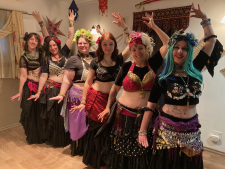on Mon, 19 Jun, 2023

Right now I have two dance troupes I “manage.” And by manage, I mostly mean I teach and cheerlead as much as I can and say, “You’ve got this.” Before Bellissimo Fusion had their first show, one of the students asked, “Wait a minute, you aren’t going to perform with us?”
I was glad I didn’t. It set them up not to depend on me. With migraines, I can’t always perform.
Let me tell you about these beautiful belly dancers and the styles we are performing.
Fusion Fascination and Bellissimo Fusion currently has members with eclectic backgrounds who have danced all kinds of styles of dance in the past. One of my dancers uses to perform African dance, another used to perform Bhangra. One dancer immigrated from Ukraine/Russia and another Bulgaria/Hungary, both who bring their own cultures and musical talents and aesthetics into our group, a members who has Turkish ancestry, who brings her cultures and experiences to their dance. Members dance in a style that evokes Indo-European roots.
Americans have the misconception that belly dance is only Middle Eastern, but as I have written about in other articles, I will mention here in case you haven’t read them, the Ottoman Empire’s reach across Europe, Asia, and Africa for hundred of years influenced the cultures they invaded. These influences can still be seen in those cultures today. Troupe member, Diana Smith shared information about this with me in her own culture when I wrote this article.
When I used to perform solos, I was primarily dancing fusion to Electro-swing, tango, or Eastern European music—depending on the costume and style I wanted to evoke as a theme. I studied many forms of breakdance in Japan for the two years I lived there to become a better fusion dancer and incorporated this into my solos.
Fusion Fascination performs a style in between fusion (an eclectic mix of modern and contemporary dances as well as other dances I have studied and can teach) and a folkloric-inspired style termed ATS. This abbreviation, ATS used to be called American Tribal Style or tribal.
Many Americans have felt a kinship and connection with folkloric dances from Europe and dance to music that they have affectionately called “Gypsy” in the past. I use this term educationally for those uninformed, but largely the belly dance community has moved away from using this term because it is considered culturally insensitive and a racial slur. Those who embrace this romanticized term mean say it with the utmost love and respect, though it hasn’t been received that way.
It also has been used inaccurately to lump many cultures together rather than using the actual cultures’ names, which is considered a form of cultural appropriation. Roma, Rom, Romany, or Tzigani-style dance when combined with belly dance is a specific style. Many American belly dancers who were calling themselves “Gypsy style belly dancers” back in the 1990s were drawing inspiration from Balkan, Spanish Andalusian, Flamenco, and Eastern European folkloric dances. Many dancers still draw from their European roots, but have a hard time pinpointing origins of moves that have evolved so much over time. I understand it is far less romantic and flowery to call this Indo-European Belly Dance, but that would be much more accurate than “Gypsy” or Roma. Belly dancers are still struggle with ways to overcome the complex nuances of naming what they do and the best way is to just explain what cultures and styles they are performing when asked.
When I first met Diana Yochkova Smith, I noticed her olive complexion and accent and assumed she was probably Hispanic, but I didn’t inquire. It was quite some time before I found out she was Bulgarian. When I interviewed Diana for my article in The Chronicle related to belly dance, it was interesting to hear Diana’s experiences with dance in her own country of Bulgaria. Most Americans do not realize how widespread the reach of the Ottoman Empire was in Europe. They left many cultural traditions in in their wake after their occupation of the countries they left.
I also have students like Lydia who is Turkish. She has a tan complexion, but her hair is so light, most would have no idea she was Turkish. We are so excited she is going to Turkey this summer to bring back fabric from her country to share with us for our costumes. People might not realize I am Italian from my fair complexion, though they would have never miss my mother or grandmother with their dark features. My only give away is how much I talk with my hands. It’s natural I have to channel some of that kinesthetic energy into dance. I have been implementing elements of the tarantella, an Italian folk dance into one of our bellydance lessons because of my Italian ancestry. I am hoping we can all bring elements of our cultures to the dances we are sharing and educate the audience about our cultures in ways that are both fun and memorable.
Dance is like a tapestry with threads that connect us in many different directions.
If you would like to read more about the article I wrote for the Chronicle on cultural appropriation, Diana's heritage, and Middle Eastern women's views on American's performing belly dance please click here: https://www.bellydanceeugene.com/blog/entry/article-in-the-chronicle-examining-appreciation-versus-appropriation-in-bel